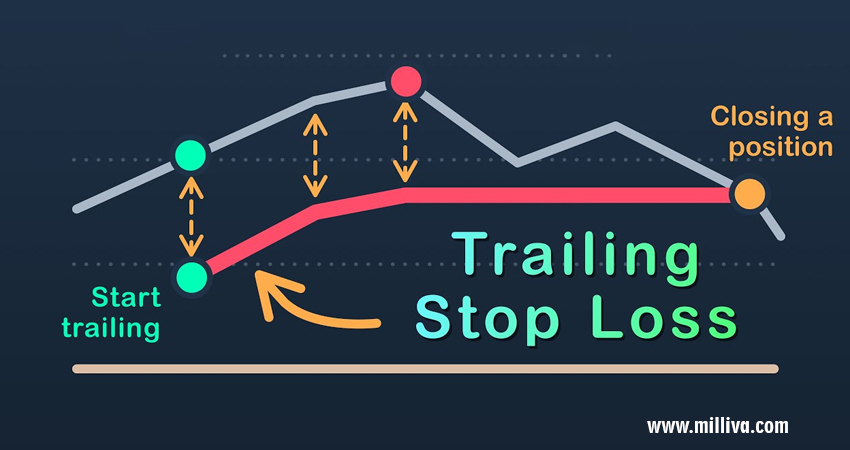What is Trailing Stop Order and Stop-Loss Order

![]()
Traders employ a variety of strategies to boost their gains and reduce their losses. Stop-loss orders and trailing stop orders are two examples of such strategies. You can define the circumstances that will automatically result in an order to sell your any form of stop order. You can protect yourself against downturns by using them because you don’t have to be present to sell your position.
Using a Plan of Exit
Having an exit strategy before you buy your position is beneficial whether you trade stocks, bonds, or other instruments. Rationale behind this is because having an exit strategy enables you to lessen the emotional pulls of greed and fear.
For instance, you might wish to refrain from exiting position too soon without allowing enough time for prices to change. You might avoid selling in panic when prices drop by 5 percent. Your exit strategy is to hold onto your stake until a price decline of, say, 10%. Stop orders give you a way to put your exit strategy into action.
Selling Your Position Manually
You can sell part or all of your position at any moment by calling your broker. Using an online trading platform. Enter market order if you wish your order to be executed right away. Position sold using this sort of order at the current bid price. With market order you are guaranteed quick execution but have no influence over the price you will pay.
You enter a limit order if you want to indicate the lowest selling price you’ll accept.
In this you can ensure the price you get won’t be lower than the limit. But there is no guarantee that the sell order will actually go through. Limit orders can be entered in advance, but market orders must be entered right once. However, you can pre-enter market orders that execute in accordance with your specified circumstances using trading stops. Limit orders can be made to last for a single day, until they execute, or until they are cancelled.

Understanding Trailing Stop Limit vs Stop-Loss Orders
A stop-loss order directs the sale of your stake if prices drop below a certain threshold. Assume, for instance, that you hold 100 shares of the XYZ stock, which is now trading for $90 per share. You place stop-loss order for $87 because you want to exit your position if the stock drops below that price.
Your broker will place a market order if the price ever drops to $87 or less. Note that there is no guarantee that the final price you pay will be $87. Once the market order is entered, it will simply be the following bid that becomes available.
it’s more convenient for you. You can place stop limit order in this case you give stop price to initiate the order. Limit price to indicate lowest price you’ll accept.
An order with a stop price of $87 and a limit price of $86 might be entered, for instance. Your sell order might not go through if XYZ shares. Suddenly drop from $90 to $80 since the lowest price you’ll accept is $86.
Recognizing the Trailing Stop Limit
When a security’s price declines by trailing amount trailing stop is triggered (i.e., a certain percentage or dollar amount). As an illustration, you might instruct a trailing stop to sell your XYZ shares at a 5% trailing stop loss percentage.
When the stock declines 5% from its most recent high, it activates. Imagine, for the sake of illustration, that the price of XYZ stock has been steadily rising, peaking at $100 per share.
If the XYZ shares fall to $95 or less, your 5 percent trailing stop would cause a sell order to be placed. The sell order at $95 will be treated as a market order if you included a trailing stop loss. Instead, you might utilize a trailing stop limit that also includes a limit price you predetermine.
Instead of utilizing a percentage, you might specify a trailing stop using an absolute price movement, such as $5.
As a result, the percentage distance drops with an absolute trailing amount while the trailing % stays at a constant percentage below as the position’s price grows.
As an illustration, if XYZ shares go to $120, a $5 trailing stop would go into effect at $115, representing a 4.2 percent decline. If you had set a 5 percent trailing stop, it wouldn’t go into effect until the shares dropped to $114 by 5 percent.
Comparing Stop Loss and Trailing Stop Limit
Main distinction between stop loss and trailing stop is that if price of the position increases, the trailing stop is pulled upward by the trail amount. Assume for the sake of the example that XYZ shares recover after dropping from $100 to $97 and go back up to $100.
The trailing stop price resets with each new high. For instance, in the event that the price increases to $105, your 5 percent trailing stop will go into effect if the shares drop to $99.75. Unless you change the stop loss order, a stop loss set at, say, $95 remains in force at that price regardless of the position’s price movement.
Your Stop Orders Updated
By altering the stop price, you can always update your stop orders (and optionally, the limit price). You can raise the stop loss price by entering a new order if you placed a stop loss and the position increases in value. Old order instantly cancelled when new one placed. You can manually mimic the impact of a trailing stop order in this way.
Traders frequently adjust their trailing stops. You could “tighten up your stop,” for instance, by lowering it from, say, 5 percent to 3 percent. Additionally, you can relax your trailing stop. Naturally, you have the option to cancel any stop order before to execution, but doing so will result in no automatic price protection should prices unexpectedly plummet.
Recognizing Buy Stops
The operation of purchase stops and buy trailing stops is exactly the opposite of that of sale stops. To safeguard short positions, buy stops and purchase trailing stops are frequently employed. For instance, you may borrow some XYZ stock from your broker and then sell it for $100 to acquire a short position in the company.
You will eventually need to buy the shares again and give them to your broker. Selling short is a wager that prices will decline. Difference between price you paid to sell shares and the amount you pay to purchase them again is your profit.
You can place a purchase stop or buy trailing stop to shield your short position against rising prices. If you short XYZ shares at $100, for instance, you can place a purchase stop that will trigger at, say, $103, as an example. An alternative is to enter a trailing stop, such as 5%. Upon reaching $105 the trailing stop will activated if prices move above $100. Falling prices push down your trailing stop price.

Visit us : www.milliva.com






Avoid forex losses- follow simple steps
20th Jul 2022[…] significant news events. A severe or unexpected slide will be avoided as a result. Simply using a stop-loss order will ensure that you leave should the value of your assets […]
Trading Signals In Forex How To Read and Use them
14th Aug 2022[…] to a stop-loss signal, a take profit signal is activated when a profit level reaches a predetermined rate. When a […]
How to Implement Trailing Stop Loss in Forex
18th Aug 2022[…] your losses, which is its principal benefit. Until you close out your position or cancel the order, stop-loss orders are in […]
Is Day Trading Profitable Strategy
21st Oct 2022[…] keep your losses to 1% and your gains to 1.5% if you stick to a 1% risk strategy, make stringent stop-loss orders, and define profit-taking levels. But doing this requires […]
Best Forex Strategy for Consistent Profits
02nd Dec 2022[…] instance, if a trader aims to gain 100 pips from a given position, you should consider setting the stop-loss order below 50 pips of the current market price. However, always remember that the setup should […]